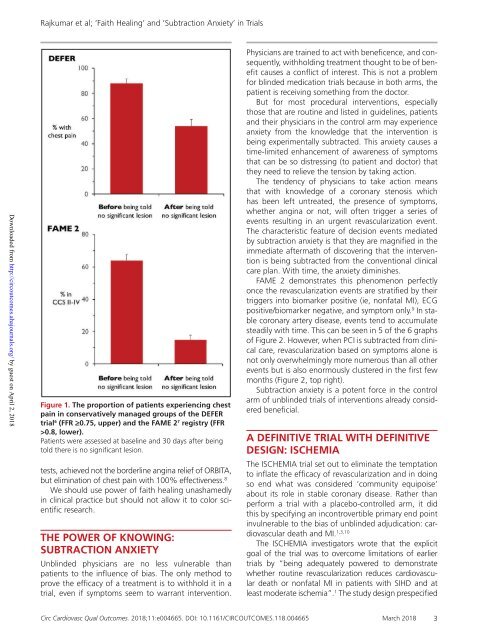Faith Healing and Subtraction Anxiety - Rajkumar - Circ CQO 2018
You also want an ePaper? Increase the reach of your titles
YUMPU automatically turns print PDFs into web optimized ePapers that Google loves.
<strong>Rajkumar</strong> et al; ‘<strong>Faith</strong> <strong>Healing</strong>’ <strong>and</strong> ‘<strong>Subtraction</strong> <strong>Anxiety</strong>’ in Trials<br />
Downloaded from http://circoutcomes.ahajournals.org/ by guest on April 2, <strong>2018</strong><br />
Figure 1. The proportion of patients experiencing chest<br />
pain in conservatively managed groups of the DEFER<br />
trial 6 (FFR ≥0.75, upper) <strong>and</strong> the FAME 2 7 registry (FFR<br />
>0.8, lower).<br />
Patients were assessed at baseline <strong>and</strong> 30 days after being<br />
told there is no significant lesion.<br />
tests, achieved not the borderline angina relief of ORBITA,<br />
but elimination of chest pain with 100% effectiveness. 8<br />
We should use power of faith healing unashamedly<br />
in clinical practice but should not allow it to color scientific<br />
research.<br />
THE POWER OF KNOWING:<br />
SUBTRACTION ANXIETY<br />
Unblinded physicians are no less vulnerable than<br />
patients to the influence of bias. The only method to<br />
prove the efficacy of a treatment is to withhold it in a<br />
trial, even if symptoms seem to warrant intervention.<br />
Physicians are trained to act with beneficence, <strong>and</strong> consequently,<br />
withholding treatment thought to be of benefit<br />
causes a conflict of interest. This is not a problem<br />
for blinded medication trials because in both arms, the<br />
patient is receiving something from the doctor.<br />
But for most procedural interventions, especially<br />
those that are routine <strong>and</strong> listed in guidelines, patients<br />
<strong>and</strong> their physicians in the control arm may experience<br />
anxiety from the knowledge that the intervention is<br />
being experimentally subtracted. This anxiety causes a<br />
time-limited enhancement of awareness of symptoms<br />
that can be so distressing (to patient <strong>and</strong> doctor) that<br />
they need to relieve the tension by taking action.<br />
The tendency of physicians to take action means<br />
that with knowledge of a coronary stenosis which<br />
has been left untreated, the presence of symptoms,<br />
whether angina or not, will often trigger a series of<br />
events resulting in an urgent revascularization event.<br />
The characteristic feature of decision events mediated<br />
by subtraction anxiety is that they are magnified in the<br />
immediate aftermath of discovering that the intervention<br />
is being subtracted from the conventional clinical<br />
care plan. With time, the anxiety diminishes.<br />
FAME 2 demonstrates this phenomenon perfectly<br />
once the revascularization events are stratified by their<br />
triggers into biomarker positive (ie, nonfatal MI), ECG<br />
positive/biomarker negative, <strong>and</strong> symptom only. 9 In stable<br />
coronary artery disease, events tend to accumulate<br />
steadily with time. This can be seen in 5 of the 6 graphs<br />
of Figure 2. However, when PCI is subtracted from clinical<br />
care, revascularization based on symptoms alone is<br />
not only overwhelmingly more numerous than all other<br />
events but is also enormously clustered in the first few<br />
months (Figure 2, top right).<br />
<strong>Subtraction</strong> anxiety is a potent force in the control<br />
arm of unblinded trials of interventions already considered<br />
beneficial.<br />
A DEFINITIVE TRIAL WITH DEFINITIVE<br />
DESIGN: ISCHEMIA<br />
The ISCHEMIA trial set out to eliminate the temptation<br />
to inflate the efficacy of revascularization <strong>and</strong> in doing<br />
so end what was considered ‘community equipoise’<br />
about its role in stable coronary disease. Rather than<br />
perform a trial with a placebo-controlled arm, it did<br />
this by specifying an incontrovertible primary end point<br />
invulnerable to the bias of unblinded adjudication: cardiovascular<br />
death <strong>and</strong> MI. 1,3,10<br />
The ISCHEMIA investigators wrote that the explicit<br />
goal of the trial was to overcome limitations of earlier<br />
trials by “being adequately powered to demonstrate<br />
whether routine revascularization reduces cardiovascular<br />
death or nonfatal MI in patients with SIHD <strong>and</strong> at<br />
least moderate ischemia”. 1 The study design prespecified<br />
<strong>Circ</strong> Cardiovasc Qual Outcomes. <strong>2018</strong>;11:e004665. DOI: 10.1161/CIRCOUTCOMES.118.004665 March <strong>2018</strong> 3


